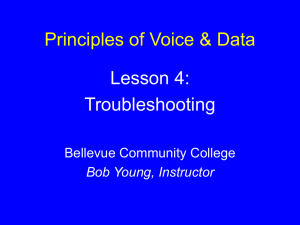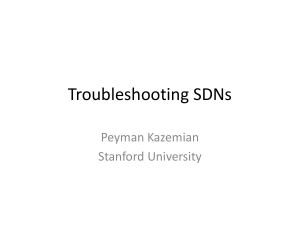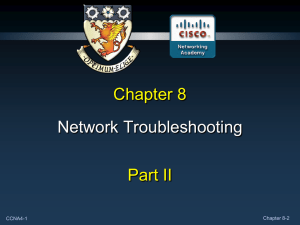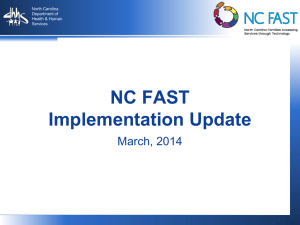Chapter 1
advertisement
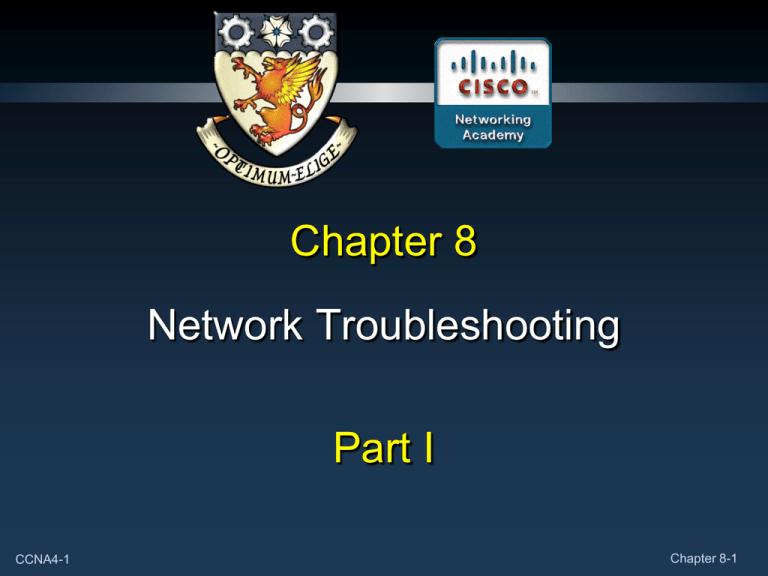
Chapter 8 Network Troubleshooting Part I CCNA4-1 Chapter 8-1 Network Troubleshooting Establishing the Network Performance Baseline CCNA4-2 Chapter 8-1 Establishing the Network Performance Baseline • To efficiently diagnose and correct network problems, a network engineer needs to know: • How the network has been designed. • The network’s expected performance. • This information is captured in the network documentation. • Network documentation usually includes 3 components: • Network Topology Diagram. • Network Configuration Table. • End-system Configuration Table. CCNA4-3 Chapter 8-1 Documenting Your Network • Network Topology Diagram: • Graphical representation of a network, illustrating how each device in a network is connected and its logical architecture. CCNA4-4 Chapter 8-1 Documenting Your Network • Network Configuration Table: • Contains accurate, up-to-date records of the hardware and software used in a network. CCNA4-5 Chapter 8-1 Documenting Your Network • End-System Configuration Table: • Contains baseline records of the hardware and software used in end-system devices. CCNA4-6 Chapter 8-1 Network Documentation Process CCNA4-7 Chapter 8-1 Network Documentation Process • Useful Commands: • ping: To test connectivity with neighbouring devices. • telnet: Log in remotely to a device for accessing configuration information. • show ip interface brief: To display the up or down status and IP address of all interfaces. • show ip route: To display the routing table in a router to learn the directly connected neighbors, more remote devices (through learned routes), and the routing protocols. • show cdp neighbor detail: To obtain detailed information about directly connected Cisco neighbor devices. CCNA4-8 Chapter 8-1 Why Establish a Network Baseline? CCNA4-9 Chapter 8-1 Steps for Establishing a Network Baseline • Three Steps: • Step 1: Determine what types of data to collect. • Start by selecting a few variables that represent the defined policies. • If too many data points are selected, the amount of data can be overwhelming. • Generally, some good measures are interface utilization and CPU utilization. What’s Up Gold CCNA4-10 Chapter 8-1 Steps for Establishing a Network Baseline • Three Steps: • Step 2: Identify those key devices and ports for which performance data should be measured. CCNA4-11 Chapter 8-1 Steps for Establishing a Network Baseline • Three Steps: • Step 3: Determine the baseline duration. • At least seven days to capture any daily or weekly trends. • Should last no more than six weeks. • Generally, a two to four week baseline is adequate. CCNA4-12 Chapter 8-1 Steps for Establishing a Network Baseline • Measuring Network Performance Data: • Sophisticated network management software is often used to baseline large networks. • Fluke Network SuperAgent. • Netscout’s Sniffer Pro. • HP Openview. CCNA4-13 Chapter 8-1 Steps for Establishing a Network Baseline • Measuring Network Performance Data: • In simpler networks, the baseline tasks may require a combination of manual data collection and simple network protocol inspectors. CCNA4-14 Chapter 8-1 Final Thoughts • To most Network Administrators, documentation is a: But (no pun intended), it is absolutely necessary for a well designed, well implemented and well maintained network. CCNA4-15 Chapter 8-1 Network Troubleshooting Troubleshooting Methodologies and Tools CCNA4-16 Chapter 8-1 General Approach to Troubleshooting • Network engineers, administrators, and support personnel realize that troubleshooting is a process that takes the greatest percentage their time. • Using efficient troubleshooting techniques shortens overall troubleshooting time. • Two extreme approaches to troubleshooting almost always result in disappointment, delay, or failure. CCNA4-17 Chapter 8-1 General Approach to Troubleshooting • At one extreme is the theorist, or rocket scientist, approach. • The rocket scientist analyzes and reanalyzes the situation until the exact cause at the root of the problem has been identified. • While this process is fairly reliable, few companies can afford to have their networks down for the hours or days that it can take for this exhaustive analysis. CCNA4-18 Chapter 8-1 General Approach to Troubleshooting • At the other extreme is the impractical, or caveman, approach. • The caveman's first instinct is to start swapping cards; changing cables; changing out or upgrading software and increasing bandwidth until, miraculously, the network begins operating again. • This does not mean that the network is working properly, just that it is operating. • It may achieve a change in symptoms faster, but it is not reliable nor does it find the root cause of the problem. CCNA4-19 Chapter 8-1 General Approach to Troubleshooting • The better approach is somewhere in the middle using elements of both. • It is important to analyze the network as a whole rather than in a piecemeal fashion. • A systematic approach minimizes confusion and cuts down on time otherwise wasted with trial and error. • This is where a well documented and maintained network will save you both time and money. CCNA4-20 Chapter 8-1 Using Layered Models for Troubleshooting • Logical networking models, such as the OSI and TCP/IP models, separate network functionality into modular layers. • When troubleshooting, these layered models can be applied to the physical network to isolate network problems. CCNA4-21 Chapter 8-1 Using Layered Models for Troubleshooting • OSI Reference Model: Application Issues. Implemented in software. Software Data Transport Issues Hardware CCNA4-22 Chapter 8-1 Using Layered Models for Troubleshooting • Devices and the OSI Model: CCNA4-23 Chapter 8-1 Using Layered Models for Troubleshooting • TCP/IP Reference Model: Application Issues. Implemented in software. Software Data Transport Issues Hardware CCNA4-24 Chapter 8-1 General Troubleshooting Procedures • General troubleshooting can be broken down into 4 stages. CCNA4-25 Chapter 8-1 General Troubleshooting Procedures • General troubleshooting can be broken down into 4 stages. Point to Ponder: Which is worse? The right answer to the wrong problem. or The wrong answer to the right problem. CCNA4-26 Chapter 8-1 General Troubleshooting Procedures • Troubleshooting Methods: • Start with the physical components of the network and move up through the layers. • A good approach to use when the problem is suspected to be a physical one. CCNA4-27 Bottom Up Chapter 8-1 General Troubleshooting Procedures • Troubleshooting Methods: • Start with the end-user applications and move down the layers of the OSI model. • This approach is good for simpler problems or when you think the problem is with a piece of software. CCNA4-28 Top Down Chapter 8-1 General Troubleshooting Procedures • Troubleshooting Methods: • Start by collecting user experience Divide and of the problem Conquer and make an informed guess as to which OSI layer to start your investigation. • e.g. If users can't access the web server and you can ping the server, then you know that the problem is above Layer 3. Chapter 8-1 CCNA4-29 General Troubleshooting Procedures • Take the time to select the most effective network troubleshooting method. • For Example: • Two IP routers are not exchanging routing information. • The last time this type of problem occurred it was a protocol issue. • You choose the divide-and-conquer troubleshooting method. • You begin testing the TCP/IP-related functions at the Data Link Layer and move up. CCNA4-30 Chapter 8-1 General Troubleshooting Procedures • Gathering Symptoms: CCNA4-31 Chapter 8-1 General Troubleshooting Procedures • Gathering Symptoms: CCNA4-32 Useful troubleshooting commands. Chapter 8-1 General Troubleshooting Procedures • Questioning Users: CCNA4-33 Chapter 8-1 General Troubleshooting Procedures • Questioning Users: • My tips: • Remember that users are now used to technological advances. • There are very few, if any, “dumb users” anymore. • Don’t portray yourself as a know-it-all. If you do, you can expect the least amount of co-operation. • Be specific in your questions at the user’s level. Point to Ponder: Which is worse? The right answer to the wrong question. or The wrong answer to the right question. CCNA4-34 Chapter 8-1 Troubleshooting Tools • A wide variety of software and hardware tools are available to make troubleshooting easier. • Gather and analyze symptoms of network problems. • Provide monitoring and reporting functions. • Establish the network baseline. • Network Management Systems (NMS). • Knowledge Bases. • Baselining Tools. • Protocol Analyzers. CCNA4-35 Chapter 8-1 Software Troubleshooting Tools • Network Management Systems (NMS). • CiscoView • HP Openview • Solar Winds • What's Up Gold • Device level monitoring / configuration. • Graphic display. CCNA4-36 Chapter 8-1 Software Troubleshooting Tools • Knowledge Bases: • On-line network device vendor knowledge bases have become indispensable sources of information. • Vendor based knowledge bases are a vast pool of searchable experience based information. CCNA4-37 Chapter 8-1 Software Troubleshooting Tools • Baselining Tools: • Can help draw network diagrams, help to keep network software and hardware documentation up-to-date and help to cost effectively measure baseline network bandwidth use. CCNA4-38 Chapter 8-1 Software Troubleshooting Tools • Protocol Analyzers: • A protocol analyzer decodes the various protocol layers in a recorded frame and presents this information in a relatively easy to use format. • Filter traffic. • Reporting. • Wireshark. • Sniffer Pro. CCNA4-39 Chapter 8-1 Hardware Troubleshooting Tools • Network Analysis Module: • Cisco Catalyst 6500 series switches and Cisco 7600 series routers. CCNA4-40 Chapter 8-1 Hardware Troubleshooting Tools • Digital Multimeters: • Digital multimeters (DMMs) are test instruments that are used to directly measure electrical values of voltage, current, and resistance. CCNA4-41 Chapter 8-1 Hardware Troubleshooting Tools • Cable Testers: • Cabling testers an be used to detect broken wires, crossed-over wiring, shorted connections and improperly paired connections. CCNA4-42 Chapter 8-1 Hardware Troubleshooting Tools • Cable Analysers: • Cable analyzers are multifunctional handheld devices that are used to test and certify copper and fiber cables for different services and standards. • Distance to performance defects. • Identify corrective actions. • Graphically display crosstalk and impedance behavior. CCNA4-43 Chapter 8-1 Hardware Troubleshooting Tools • Portable Network Analyzers: • Portable devices for troubleshooting switched networks and VLANs. • Plug in anywhere on the network. • Switch port to which the device is connected and the average and peak utilization. • Discover VLAN configuration, identify top network talkers and analyze network traffic. CCNA4-44 Chapter 8-1 Hardware Troubleshooting Tools • Portable Network Analyzers: • Portable devices for troubleshooting switched networks and VLANs. • Plug in anywhere on the network. • Switch port to which the device is connected and the average and peak utilization. • Discover VLAN configuration, identify top network talkers and analyze network traffic. CCNA4-45 Chapter 8-1


